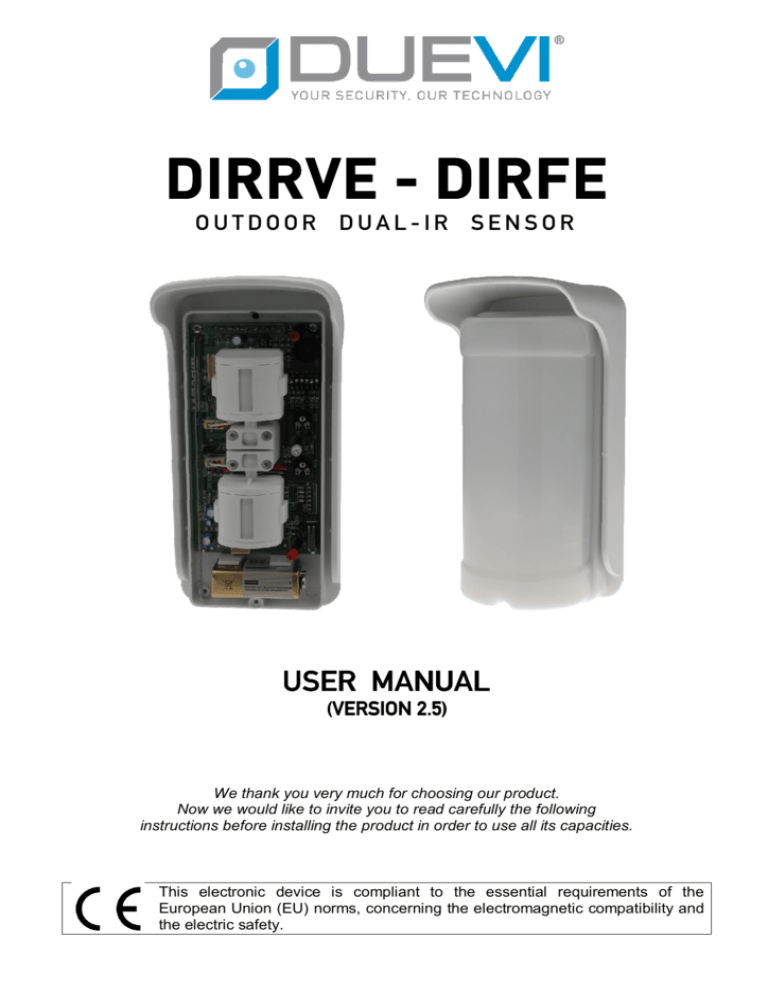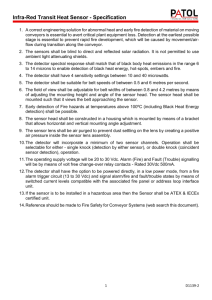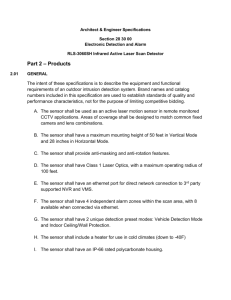Installing Instructions (PDF - 3.29mb)
advertisement

DIRRVE - DIRFE OUTDOOR DUAL-IR SENSOR USER MANUAL (VERSION 2.5 2.5) We thank you very much for choosing our product. Now we would like to invite you to read carefully the following instructions before installing the product in order to use all its capacities. This electronic device is compliant to the essential requirements of the European Union (EU) norms, concerning the electromagnetic compatibility and the electric safety. DIRRVE – DIRFE Outdoor DUAL-IR sensor DIRRVE / DIRFE is an innovative passive infrared sensor for outdoor use. It has two PIR detection heads that are completely independent and can be separately adjusted. This allow to obtain a great functioning versatility and contemporary, if correctly installed, an excellent reduction of unwanted alarm. Infact the sensor can work with two different logic combinations between the two heads: OR logic or AND logic. In OR mode, the sensor gives alarm when any one of the sensible elements detects a movement. In AND mode, the sensor gives alarm only when both elements detect a movement. It is also possible to select a directional AND mode. ALL THIS MEANS MORE SECURITY AND LESS UNWANTED ALARMS. AVAILABLE MODELS: DIRRVE wireless version DIRFE wired version Both the models are identical in functionality and optical performances. They only differ for the alarm transmission method. 2 DIRRVE-DIRFE V2.5 This manual can be modified without any warning WARNING DIRRVE-DIRFE HAS BEEN DESIGNED TO GUARANTEE A VERY HIGH IMMUNITY TO LIGHT INTERFERENCE, HOWEVER VERY BRIGHT LIGHT CAN PRODUCE A RANGE DECREASE. IT IS THEREFORE RECOMMENDED TO TAKE GREAT CARE IN INSTALLATION TO AVOID DIRECT OR REFLECTED SUNLIGHT OR HIGH INTENSITY LIGHT BEAMS IT IS RECOMMENDED TO USE THE OUTDOOR SENSOR AS AN ADDITIONAL TOOL TO A SECURITY SYSTEM AND NOT FOR ACTIVATING DIRECTLY ALARM TOOLS AS SOUNDERS AND PHONE DIALLERS AVOID TO ORIENT THE SENSOR TOWARDS MOVING OBJECTS SUCH AS BUSHES, FLAGS, BRANCHES ETC, IN ORDER TO AVOID UNWANTED RELEVATION IN OUTDOOR INSTALLATION, IT IS RECOMMENDED TO USE THE SENSOR IN THE “AND MODE” FOR A BEST IMMUNITY TO UNWANTED ALARMS AND TO SET BOTH ELEMENTS IN THE SAME DIRECTION. INCORRECT INSTALLATION COULD REDUCE SECURITY LEVEL. THE SENSOR DIRRVE HAS AN IP54 PROTECTION LEVEL AGAINST THE DUST AND WATER. IF POSSIBLE, IT IS ANYWAY RECOMMENDED TO AVOID INSTALLING THE SENSOR IN AREAS DIRECTLY EXPOSED TO RAIN OR SNOW. DO NOT SPRAY ANY HIGH PRESSURE WATER ON THE SENSOR. WHEN POSSIBLE INSTALL THE SENSOR IN SHELTERED AREAS OR MOUNT IT ON THE DEDICATED BRACKET (STA). TO HAVE THE IP54 LEVEL IT IS MANDATORY TO INSERT THE ORING INCLUDED IN THE PACKAGE. IF YOU DO NOT COMPLY WITH THE ABOVE MENTIONED RECCOMANDATIONS, IT MAY CAUSE A NOT CORRECT WORKING OF THE SENSOR AND IN SUCH AN EVENT, THE MANUFACTURER WILL DECLINE ANY RESPONSIBILITY. 3 DIRRVE-DIRFE V2.5 This manual can be modified without any warning PROPER USE OF THE SENSOR DIRRVE/DIRFE sensor can be fixed at height between 80 and 250 cm from the ground level, on vertical surfaces, walls or posts using the fixing and protecting provided visor. Each detection unit is equipped with a Fresnel lens that builds 5 double sectors beams horizontally oriented with a radial aperture of 100° (Fig.1). Fig. 1 - View of the beam’s sectors NOTICE The IR sensor is sensible to the “amount of heat” emitted by a moving body. The maximum range of the sensor (measured in meters) is referred to a human body. However the same “amount of heat” may be emitted by a smaller body at lower distances, or by a larger one at greater distances. It should be considered therefore that the range of any passive infrared sensor is a RELATIVE measure (referring to a human body) and NOT ABSOLUTE (for any body). IR sensor Range (m) 4 DIRRVE-DIRFE V2.5 This manual can be modified without any warning OUTDOOR USE The detecting units MUST be adjusted in order to have beams facing downward to the ground level or parallel to the ground, but NEVER upward. This is to avoid situations of blinding by sunlight during the day and to prevent the not-correct working of the sensor. The two detecting units MUST be adjusted on the vertical axis in order to the two beams pattern slight divergent: the upper unit see the most distant area, the lower one see the nearer area. In this way, using the AND logic, an alrm is triggered only when a human intruder crosses both the beams. The alarm is not triggered when only one beam is crossed for example by an animal or objects that you do not want to be considered intruders. NO ALARM ALARM NO ALARM Fig. 2 - AND logic mode: the human trigger alarm, the dog doesn’t. The function of "directional AND" allows to further refine the way in which an alarm is triggered. This mode make the sensor to trigger an alarm only after a sequence of detection that starts with the upper head (farther beams) and end, within the AND period, with the lower head (closest beams). This feature allows to give a directionality to the detection, that means the sensor is able to identify an intruder approaching the protected zone, avoiding alarms for people who, even if moving inside the detection zone of the upper head, are not approaching the protected zone. 5 DIRRVE-DIRFE V2.5 This manual can be modified without any warning NOTICE Take in consideration that small alterations of the head position corresponds to large modifications (at distance of 12 m) of the beams detecting zones. Consider that a 1° horizontal rotation of the head corresponds to a 20 cm shift of the beams at a distance of 12 m. It is then recommended to execute a very meticulous regulation and several tests in order to obtain the wanted result. To avoid unwanted alarms, NEVER adjust detecting heads allowing the beams to be parallel to the ground level. The beams should always finish against some surface (wall, ground) to have a well-defined detection area not pointing towards the open space (see Fig. 3). NEVER ADJUST heads directly toward reflective surfaces, in order to prevent unwanted alarms. Typical examples of reflective surfaces are: windows, glass walls, water puddles, wet roads, smooth concrete surfaces, paved roads. The amount of reflection of these surfaces is not of course 100 %, however, if the heat source is very strong, reflection may be sufficient to trigger an alarm (see Fig. 4). 6 DIRRVE-DIRFE V2.5 This manual can be modified without any warning OK NO!! Fig. 3 - Avoid to have beams parallel to the ground level. NO!! Fig. 4 - Avoid to have beams toward reflecting surfaces. 7 DIRRVE-DIRFE V2.5 This manual can be modified without any warning INDOOR USE The indoor installation allows greater flexibility of use, as sources of unwanted alarms are significantly reduced compared to the outdoor environment. In addition to the modes already described for the outdoor use, it is possible to adjust the detection heads also divergent in the horizontal plane. This allows to get different combinations of protection. For example it is possible to adjust heads forming a 90° angle in order to obtain a protected zone with semicircle shape, equivalent to that generated by 180° aperture lens. According to the selected logic (OR, AND, directional AND) you can have the sensor working in different ways. Lower head Upper head Top view Top view Top view (1) OR Logic (2) AND Logic (3) Directional AND Logic The sensor gives alarm when it detects a movement in any of the areas covered by the two heads. The sensor gives alarm only when it detects a movement crossing both the areas, not considering the direction. The movement inside only one area do not trigger an alarm. The sensor gives alarm only when it detects movement crossing from the upper head area to the lower one. DIP1=ON DIP1=OFF DIP3=OFF DIP1=OFF DIP3=ON 8 DIRRVE-DIRFE V2.5 This manual can be modified without any warning INSTALLATION OF THE SENSOR Mount the sensor at height between 80 cm and 250 cm from the ground level. Position the sensor considering the coverage of an area with maximum distance of 12 m and radial aperture of 100 degrees. Device may not detect Device detects For a reliable and repeatable detection, it is recommended to install the sensor so that the intruder cross beams perpendicularly and not with a frontal approach. Once positioned the sensor, to adjust the heads, it is advisable to slightly untighten the screws of joints. Proceed with the "calibration" of the sensitivity of detections heads, starting with the minimum value of sensitivity (trimmer completely rotated counterclockwise) and the heads as downward as possible. Increase gradually sensitivity and orientation of the heads in order to obtain a detection only in the area that is to be protected and no alarms outside that area. Once finished the adjustment, tighten the screws of joints. NOTICE The external cover of the sensor causes an attenuation of about 30 % of the length of the beams. This should be considered during the setting operations. WARNING POWERING THE SENSOR WHILE THE TAMPER JUMPERS ARE CLOSED WILL DISABLE THE SUPERVISION CODE TRANSMISSION. THIS IS SIGNALED BY THE BLINKING OF THE BLUE LED (10 TIMES). THE SENSOR WILL BE ACTIVE AND STABLE ONLY ABOUT 20 S AFTER THE RED LEDS START BLINKING. 9 DIRRVE-DIRFE V2.5 This manual can be modified without any warning PARTIAL COVERING OF THE LENS In some environment the detection area of the heads can be too wide and be a potential source of problems if inside the area to be protected there are tree branches, curtains, windows, etc. Under these conditions it is possible to reduce the detection area by masking appropriately lateral or intermediate beams with adhesive tape placed over sectors of head lens (beams blinding), leaving it able to detect only the beams oriented towards stable zones of detection. This precaution avoids unwanted alarms raised by wind, moving branches, curtains or other objects present in the area. In the sensor package are included two plastic lens-covers to be applied to the detection heads in order to obtain a CURTAIN EFFECT. With such a cover, the beam detection sector is reduced to 20°, having the same detection range. The lens cover is to be inserted pressing it on the detection head as showed in following figures. Pay attention to correctly lock the two hook on the sides of the cover and that the lens cover is well fixed on the detection head. HEAD WITH CURTAIN EFFECT LENS COVER VERIFY THAT THE HOOKS ARE WELL FIXED IN THEIR JOINT HEAD WITH STANDARD LENS 10 DIRRVE-DIRFE V2.5 This manual can be modified without any warning WALL MOUNTING 1. Use the visor as mask to mark the position of holes on wall (A and B), then drill and insert provided dowels: 2. Insert the TAMPER adjustment screw in dowel (B) leaving protrude its head about 9 ÷ 10 mm from wall surface: A TAMPER adjustment screw B A B 3. Overlap the visor to the detector: fine adjust TAMPER screw so that fixing the detector, the tamper switch is well pressed without break circuit: A About 9 ÷ 10 mm A B A A TAMPER protection headset Wall A TAMPER adjustment Visor Detector B A A 11 DIRRVE-DIRFE V2.5 This manual can be modified without any warning 4. Fix detector and visor to wall (E points matching to A holes) by the three appropriate screws, taking care to add BLACK o-rings on each and placing the RED o-ring in its appropriate position: Note for DIRFE version Before fix the detector to wall it is necessary to pass the cables through appropriate holes. Break one or more pre-marked hole-places (up to needs) on visor (C) and detector support platform (D): DIRFE detector E x3 Place here RED O-ring Visor Break septums for passing cables E E 5. Insert the cover over detector platform starting from the top (hooking the two locking tabs). Fix (F) the cover by appropriate screw taking care to insert the BLACK o-ring: C D Pass cables through holes (C and D) and proceed with installation as follows. x1 F F Cables path 12 DIRRVE-DIRFE V2.5 This manual can be modified without any warning LAYOUT AND SETTINGS TAMPER ALARM GND +12 V JUMPERS JP5 Wall Tamper Closed = tamper disabled Open = tamper enabled JP6 Cover Tamper Closed = tamper disabled Open = tamper enabled JP4 JP7 Testing Buzzer Closed = buzzer enabled (only when DIP4 ON) Open = buzzer disabled Alarm Led (BLUE) Closed = led enabled Open = led disabled RANGE TRIMMER R25 Upper head Trimmer to adjust the detection depth of the upper head. Turn clockwise to increase the detection range. R26 Lower head Trimmer to adjust the detection depth of the lower head. Turn clockwise to increase the detection range. 13 DIRRVE-DIRFE V2.5 This manual can be modified without any warning DIP-SWITCH DIP1 Sensor Logic DIP2 IR sensitivity DIP3 AND-mode selection DIP4 Test DIP5 Continuous Transmission (DIRRVE MODEL) Continuous Detection (DIRRVE MODEL) DIP6 (*) OFF = heads work with AND logic ON = heads work with OR logic OFF = HIGH sensitivity (for indoor use) ON = LOW sensitivity (for outdoor use) OFF = NORMAL AND Alarm is triggered with a detection that starts from any head and, within the AND time, ends by the detection of the other head. If during the “AND” time the second head doesn’t detect anything, the sensor returns in stand-by mode. ON = DIRECTIONAL AND Alarm is triggered only with a detection that starts from the upper head and, within the AND time, ends by the detection of the lower head. If during the “AND” time the lower head doesn’t detect anything, the sensor returns in stand-by mode. OFF = Normal Operation (Test OFF) ON = Test Mode It enables the detection led of any head, the alarm led and the buzzer emission (if JP4 is closed), useful to test the coverage area. OFF = Normal Operation ON = Enables the wireless transmission once a second to test the maximum transmission range. OFF = Detection with quiet time Alarm is triggered only if occurs a time gap of more than 30 seconds (quiet time) from the last alarm. If within this time it is detected another movement, the sensor resets to zero the quiet time. If no movement is detected, after the quiet time the sensor is ready to trigger a new alarm. This function is particularly useful in very crowded places, to extend the battery life. ON = Continuous detection Alarm is triggered every time heads detect a movement. (*) NOTICE: When DIP6 is changed from OFF to ON, before to obtain a real change in working mode, it is mandatory to avoid the sensor to detect a movemen until the quiet time is ended, otherwise the sensor will continue to work as the DIP6 is in the OFF position. 14 DIRRVE-DIRFE V2.5 This manual can be modified without any warning TECHNICAL FEATURES POWER SUPPLY CONSUMPTION LOCAL SIGNALLING ALARM INPUTS TEST WIRELESS SECTION REMOTE SIGNALLING Battery 9 V Stand-by < 15 uA – ALARM < 10 mA 1 Led for upper head, 1 Led for lower head, 1 Led for alarm transmission 2 IR sensible elements, programmable with OR / AND logic Test function selectable by dipswitch with led display and buzzer TX 433,92 MHz (100 m range) TX alarm, tamper, low battery, supervision. TECHNICAL FEATURES POWER SUPPLY CONSUMPTION LOCAL SIGNALLING ALARM INPUTS TEST OUTPUTS (DIRRVE – wireless) (DIRFE – wired) 12 V Stand-by < 20 mA – ALARM < 100 mA 1 Led for upper head, 1 Led for lower head, 1 Led for alarm transmission 2 IR sensible elements, programmable with OR / AND logic Test function selectable by dipswitch with led display and buzzer Alarm relay, Tamper. 15 DIRRVE-DIRFE V2.5 This manual can be modified without any warning







